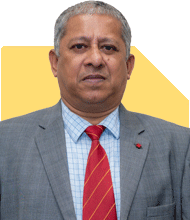36-Year-Old Woman Seeking Financial Advice: Building a Corpus for Family and Buying a Flat
Ramalingam Kalirajan |8319 Answers |Ask -Follow
Mutual Funds, Financial Planning Expert - Answered on Jul 31, 2024
He has an MBA in finance from the University of Madras and is a certified financial planner.
He is the director and chief financial planner at Holistic Investment, a Chennai-based firm that offers financial planning and wealth management advice.... more

I am 36 yr old female serving in govt service from last 8 years. Current in hand salary is around 86000. I have 44000 loan payment due for next 9 years. I am saving in NPS as per govt rules of deductions. Can u suggest how I can build good corpus for family as I am the only earning member with 2 young boys ageing 5 and 1n half. I started saving 15000 in MF sip from last 2 months. How much corpus will be required. I have my own house in Delhi and 1 small flat in Gurgaon. How can grow all this in this future planning and investments.. I want to. Buy a big flat in Gurgaon but right now I don't have savings. Plz suggest how can I make it possible.
Age: 36 years
Occupation: Government service (8 years)
Monthly Salary: Rs 86,000 (in-hand)
Monthly Loan Payment: Rs 44,000 (for next 9 years)
Savings in NPS: Mandatory government deductions
Mutual Fund SIP: Rs 15,000 (started 2 months ago)
Real Estate: Own house in Delhi and a small flat in Gurgaon
Family: Single earner with two young boys (ages 5 and 1.5 years)
You have a stable job and a clear focus on future planning. Your current investments and real estate assets are good starting points.
Assessing Your Goals
Goal 1: Build a Good Corpus for Family
Time Frame: Long-term (15-20 years)
Primary Need: Financial security for your children’s future
Action: Systematic and disciplined investment in mutual funds and NPS
Goal 2: Buy a Bigger Flat in Gurgaon
Time Frame: Medium-term (5-10 years)
Primary Need: Larger living space in a desirable location
Action: Save aggressively for down payment and plan for a home loan
Recommendations for Investment Strategy
Increase SIP Contributions
Current SIP: Rs 15,000 per month
Suggested Action: Gradually increase SIP contributions as income grows
Fund Selection: Focus on diversified equity mutual funds for long-term growth
Utilise NPS Benefits
Current Savings: NPS as per government rules
Action: Consider making additional voluntary contributions to NPS for higher corpus and tax benefits
Emergency Fund
Importance: Essential for unexpected expenses
Action: Build an emergency fund covering 6-12 months of expenses
Placement: Keep this in liquid funds or a high-interest savings account
Insurance Review
Life Insurance: Ensure adequate coverage for family’s security
Health Insurance: Adequate health coverage for yourself and children
Loan Management
Current Loan: Rs 44,000 per month for 9 years
Action: Continue regular payments; consider prepaying if possible to reduce interest burden
Steps to Achieve a Bigger Flat in Gurgaon
Save for Down Payment
Time Frame: 5-10 years
Action: Allocate a portion of savings specifically for down payment
Investment: Consider short-term debt funds for safety and modest returns
Plan for Home Loan
Preparation: Ensure good credit score and stable financial profile
Loan Tenure: Choose a tenure that keeps EMI affordable within your budget
Increase Savings Rate
Current Savings: Rs 15,000 in SIPs
Suggested Action: Aim to save at least 20% of your income for goals
Building a Retirement Corpus
Set Clear Goals
Target Retirement Age: Determine when you plan to retire
Required Corpus: Estimate the amount needed to sustain your lifestyle post-retirement
Regular Contributions
Increase SIPs: Aim to increase your SIP contributions annually
Consistent Savings: Ensure regular and disciplined savings for long-term growth
Automatic Investments: Set up automatic transfers to investment accounts
Final Insights
You have a solid foundation with a stable job and clear goals. Increase your SIPs, make additional contributions to NPS, and build an emergency fund. Save aggressively for the down payment of a bigger flat and manage your loan efficiently. Regularly review your financial situation and consult a certified financial planner.
Best Regards,
K. Ramalingam, MBA, CFP,
Chief Financial Planner,
www.holisticinvestment.in
You may like to see similar questions and answers below
Ramalingam Kalirajan |8319 Answers |Ask -Follow
Mutual Funds, Financial Planning Expert - Answered on May 16, 2024
Ramalingam Kalirajan |8319 Answers |Ask -Follow
Mutual Funds, Financial Planning Expert - Answered on May 28, 2024
Milind Vadjikar |1206 Answers |Ask -Follow
Insurance, Stocks, MF, PF Expert - Answered on Jan 27, 2025
Ramalingam Kalirajan |8319 Answers |Ask -Follow
Mutual Funds, Financial Planning Expert - Answered on Feb 27, 2025
Dr Nagarajan J S K |367 Answers |Ask -Follow
NEET, Medical, Pharmacy Careers - Answered on May 05, 2025
Prof Suvasish Mukhopadhyay |615 Answers |Ask -Follow
Career Counsellor - Answered on May 05, 2025
Dr Dipankar Dutta |1197 Answers |Ask -Follow
Tech Careers and Skill Development Expert - Answered on May 05, 2025
Radheshyam Zanwar |1599 Answers |Ask -Follow
MHT-CET, IIT-JEE, NEET-UG Expert - Answered on May 05, 2025
Radheshyam Zanwar |1599 Answers |Ask -Follow
MHT-CET, IIT-JEE, NEET-UG Expert - Answered on May 05, 2025

EEE (Electrical and Electronics Engineering) at IIIT Gwalior (ABV-IIITM) can be a decent choice. But if you're strictly interested in core electrical engineering, other colleges (like NITs) might be a better option because not many EEE-core companies visit the campus in comparison to CS/IT branches. Finally, if your interest is strictly in core EEE, IIIT Gwalior might not offer as many labs or core recruiters as older NITs or IITs with stronger electrical departments.
Follow me if you like the reply. Thanks
Radheshyam
If not followed, pl follow and like. Thanks
Radheshyam Zanwar |1599 Answers |Ask -Follow
MHT-CET, IIT-JEE, NEET-UG Expert - Answered on May 05, 2025
Prof Suvasish Mukhopadhyay |615 Answers |Ask -Follow
Career Counsellor - Answered on May 05, 2025

Prof Suvasish Mukhopadhyay |615 Answers |Ask -Follow
Career Counsellor - Answered on May 05, 2025

Mihir Tanna |1052 Answers |Ask -Follow
Tax Expert - Answered on May 05, 2025
Samraat Jadhav |2269 Answers |Ask -Follow
Stock Market Expert - Answered on May 05, 2025























